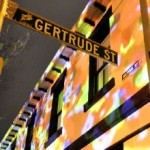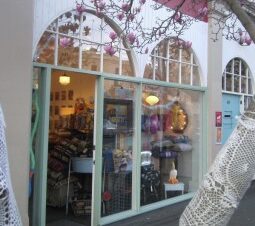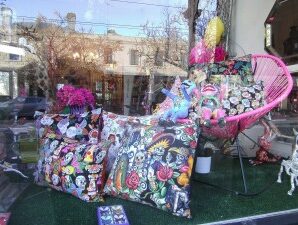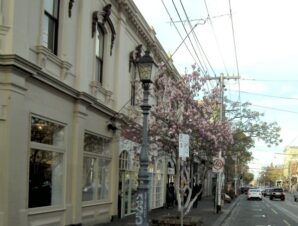Very Vintage Walk: Fitzroy 08.09.12
Product Information
 I launched my new Walk on Saturday – Very Vintage Walk: Fitzroy (VVWF). It is similar but different to my Creative Inspiration Walk, which focusses on where to get craft and art supplies in the CBD and also includes a couple of places that showcase handmade wares. VVWF is a real Fitzroy treasure hunt. My aim is to introduce eclectic, retro, uniquely handmade and vintage finds in Fitzroy, mainly around Gertrude Street. This strip is flush with rich pickings of stores, cafes and galleries – from garments and books to accessories, craft and home wares. We start at the Nicholson Street end and finish near Smith Street three hours later. Thirteen of us were treated to introductory talks by many of the proprietors, which helped to demystify the shop and its contents. Many stores offered discounts to the group and all made us feel very welcome, despite the tight squeeze in some of the more compact stops. Three hours of shopping may seem like a long time but it certainly flies by when you’re having fun. The group were such a joy to lead, and very comlimentary to boot. It was a great first Walk and I know the next one on 24th November will be just as good.
I launched my new Walk on Saturday – Very Vintage Walk: Fitzroy (VVWF). It is similar but different to my Creative Inspiration Walk, which focusses on where to get craft and art supplies in the CBD and also includes a couple of places that showcase handmade wares. VVWF is a real Fitzroy treasure hunt. My aim is to introduce eclectic, retro, uniquely handmade and vintage finds in Fitzroy, mainly around Gertrude Street. This strip is flush with rich pickings of stores, cafes and galleries – from garments and books to accessories, craft and home wares. We start at the Nicholson Street end and finish near Smith Street three hours later. Thirteen of us were treated to introductory talks by many of the proprietors, which helped to demystify the shop and its contents. Many stores offered discounts to the group and all made us feel very welcome, despite the tight squeeze in some of the more compact stops. Three hours of shopping may seem like a long time but it certainly flies by when you’re having fun. The group were such a joy to lead, and very comlimentary to boot. It was a great first Walk and I know the next one on 24th November will be just as good.
====================================================================
A QUICK HISTORY OF FITZROY
Fitzroy is steeped in indigenous history and is Melbourne’s oldest suburb. Although the original owners, the Wurundjeri people, were ‘moved on’ during colonial settlement, many indigenous people started moving back to the area during the 1930’s. They continue to call Fitzroy ‘home’ and have several Aboriginal services there.
In the 1840’s, the land was subdivided by Captain Brunswick Smythe and Benjamin Baxter and soon after Gertrude Street (named after the captain’s daughter) and Brunswick Street came into being.
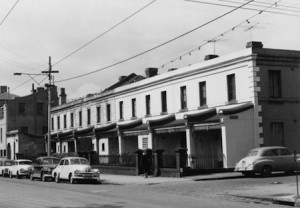 From the very beginning, Fitzroy was well-populated and soon became over-crowded and poverty-stricken with no police and many illegal grog shops and unlicensed pubs. In the 1850’s conditions improved and the oldest surviving terrace houses in Melbourne were built: the ‘Glass Terrace’, 64-78 Gertrude Street. The three landmark hotels of this area were also built at this time; the Rob Roy, the Builder’s Arms and the Renown Tavern (now the Gertrude).
From the very beginning, Fitzroy was well-populated and soon became over-crowded and poverty-stricken with no police and many illegal grog shops and unlicensed pubs. In the 1850’s conditions improved and the oldest surviving terrace houses in Melbourne were built: the ‘Glass Terrace’, 64-78 Gertrude Street. The three landmark hotels of this area were also built at this time; the Rob Roy, the Builder’s Arms and the Renown Tavern (now the Gertrude).
In the 1880’s, the shanties and temporary shacks were demolished and the area became famous for its brothels. In 1890 a depression hit Fitzroy hard and the majority of the residents relied on charities for food, shelter and clothes. The area developed a reputation for sly grog, prostitution, rival gangs and criminal activities, which lasted 100 years to 1990. During this time, after the First World War, cocaine became popular and drove rival gangs into a drug war, which culminated in a major shoot-out between gangs from Collingwood, Fitzroy and Richmond.
In the 1920’s, Gertrude Street became home to a variety of clothing factories, furniture warehouses and clothing stores. In 1931 the ‘Great Depression’ hit Melbourne. Some sections of Gertrude Street became slums as the buildings fell into disrepair and the residents into debt and poverty. Melbournians regarded Fitzroy as slum territory, the haunt of criminals and prostitutes and with the highest levels of infant mortality in Victoria. During the 1950’s the government cleared up the slums and constructed the high-rise Housing Commission estates (corner of Brunswick and Gertrude Street).
From the early 1970s, Fitzroy became a desirable place to live attracting a mixture of university students, renovators and artists. By the 1980s and 1990s it became increasingly affluent and expensive.
Twenty-first century Fitzroy is a very different location from that of previous decades. Many of its hotels have also gone, either demolished or transformed into art galleries or bars that cater to a new clientele. The Koorie community lives largely outside the suburb, but the Aboriginal Health Service in Fitzroy remains a cultural hub. Brunswick and Gertrude streets are now vibrant commercial strips that cater to tourists and residents. Smith Street is also seeing a rebirth. Where it was once a thriving shopping strip in the late 19th and early 20th century, it is slowly growing and changing to resemble its ‘sister’ streets.

